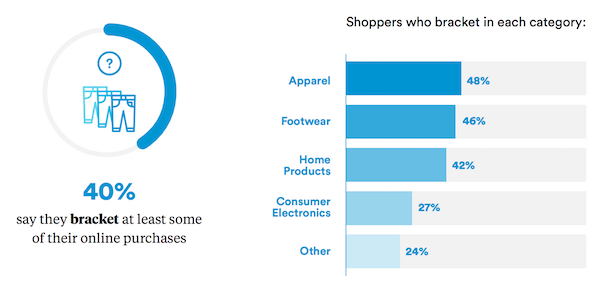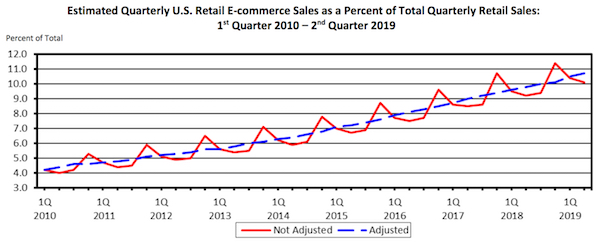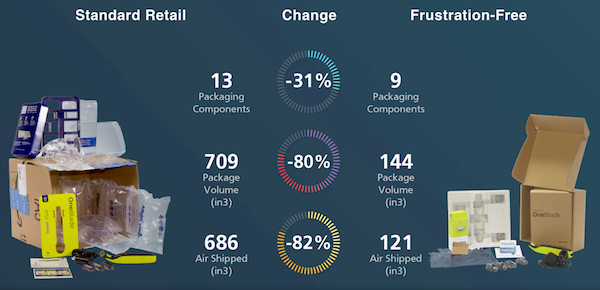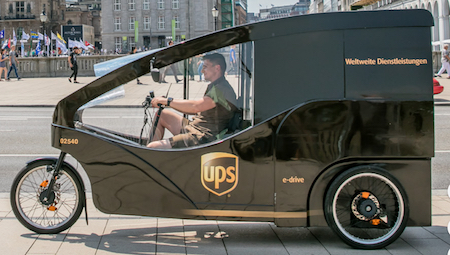If you think about the differences between in-store and online shopping for just a few minutes, you can probably come up with a pretty good list of what generates extra emissions. The trick is quantifying this, and there’s been some work on that, though more on some aspects than others. Here are some of the factors that affect shopping emissions.
Transportation. This is the biggest factor. What types of vehicles are used, how far do they go, and how full are they (of people and/or products)? People tend to view online shopping as an easy win here because products are shipped to homes more efficiently. But that’s not always the case.
Packaging. Is your recycling bin packed with cardboard boxes? Tired of popping those air bag fillers? People view in-store shopping as an easy win here, and that is usually (but not always) true.
Browsing and Returning. How are you exploring your options, how often are you returning or exchanging your purchases, and how/where are you returning them? It is often best to research items online, but sometimes there is no substitute for seeing the item in person. A store visit can help avoid a subsequent return.
Operational Overhead. What is the cost of operating the physical vs the online stores? This is an easy win for online shopping, though it is not as big a factor as the above items.
Overconsumption. How likely are you to buy something you might not have bought otherwise? Is online shopping too frictionless? Or in-store shopping too tempting?
I’m going to go over these in more detail, but keep in mind there are even more factors that come into play. As one example, Professor Arde Faghri of the University of Delaware, who led a study to evaluate the impact of online shopping in Newark, said in 2016: “We found that the total number of vehicles miles traveled hasn’t decreased at all with the growth of online shopping. This suggests that people are using the time they save by shopping on the internet to do other things like eating out at restaurants, going to the movies, or visiting friends.” Hmm. For now, let’s look at some data about shopping by itself.
Transportation Emissions
You would think this would be an easy win for online shopping. A person driving to a store surely uses more emissions than a delivery truck packed with products and routed efficiently around a residential area, right? Yes, that’s true.

Source: 2016 HBS alumni article
While some people bike or walk to stores, and some people go to stores on their way to/from work or school, online delivery is generally more efficient. An oft-cited 2013 MIT study by Dimitri Weideli, who modeled the environmental impacts of different types of shopping, indicates that the transportation emissions for in-store shopping are 2-3 times those of online shopping, even assuming you know what you want and where to find it. But when faster shipping (air delivery) is used, online transportation emissions double and the overall comparison benefits in-store shopping.

Emissions comparison for in-store (“traditional”) vs online (“cybernaut”) shopping, with the right column reflecting fast shipping (air delivery). Source: 2013 MIT study
Transmission emissions can make or break the case for online shopping. Miguel Jaller, assistant professor of civil and environmental engineering and co-lead of the Sustainable Freight Initiative at the Institute of Transportation Studies at UC Davis, says in an article he wrote for Vox: “Online shopping would be greener than driving to local stores if we did three simple things: 1) Planned ahead and consolidated our orders so we get everything we need in fewer shipments; 2) Avoided expedited shipping (even if it’s free); 3) Bought less stuff.”
Interestingly, Amazon has recently announced a feature to help people do just that (well, the first two; I’m not holding my breath for the third…). Your orders are batched up and delivered together on your chosen day of the week (“Amazon Day”), as long as you order about two days before. Fewer boxes, less hassle, and fewer emissions. You can always request faster shipping when you need something quickly. On a recent Amazon Day, I got two boxes and an envelope. One box had most of my orders, packed tightly together. The other box had a single 4-ounce bottle of vanilla wrapped in bubble wrap rattling around with a few air bags. And the envelope had a small screwdriver. I guess they were afraid the vanilla would break or leak and so packed it separately. The screwdriver was presumably at a different distribution center.
Etsy is taking a different approach. They say that a whopping “98 percent of Etsy’s total emissions stem from items shipped from our sellers to our buyers.” So they are now offsetting their shipping emissions. Offsetting is not a real fix -- it is much better to reduce the actual emissions -- but it’s a start. At the same time, shipping companies are finding ways to reduce their own emissions with better routing, more efficient vehicles, and alternative fuels.
Browsing, Returns, and Failed Deliveries
Given that transportation emissions are a big part of the carbon footprint of shopping, you want to avoid returning merchandise. A surprisingly large 20-30% of online purchases are returned, compared with about 5-10% of in-store items. Lots of information is available about returns, since the cost and overhead of processing them is a big issue for ecommerce markets. Apparel and luxury items are most likely to be returned, so it can make a lot of sense to purchase those items in stores or shop online for only those brands and styles that you are familiar with. You want to avoid being the shopper that Shopify refers to as “The Fitting Roomer” -- someone who orders several sizes or styles with the intent of returning a few.

Shoppers often “bracket” their online purchases, buying multiple items with the intention of returning some of them. Source: 2017 Narvar survey
Even though returns are not fast deliveries, they still add significantly to your shopping emissions. Failed and/or stolen deliveries can also be an issue. If you are shopping on Amazon, setting your Amazon Day for Saturday could help, or any of the other mechanisms that Amazon has set up to help with this (e.g., lockers).
Packaging
Have you ever unpacked a box in a box in a box? Packaging is a big source of emissions for online shopping, as shown in the chart from the MIT study above. It also leads to waste. While over 90% of cardboard is recycled, a typical box is just 48% recycled material. So it is important to reduce the amount that is used. One good bet is to batch your purchases. But the industry itself is changing too.
Because online shopping is becoming more common every year, some vendors are beginning to design packaging specifically for ecommerce.

Source: 2019 US Department of Commerce report
Products intended for internet sales can have much less packaging than store-oriented varieties. They do not need to be sealed in impermeable plastic to prevent theft, and they do not need to fight for an on-shelf presence. A household cleaner in a large plastic bottle can be reduced to a small tablet (just add water), and the online display-ability would not be impacted. Here is an example from Amazon showing more efficient, sustainable, and user-friendly packaging of a razor for online sales.

More efficient and “frustration free” packaging of a razor for online sales. Source: Amazon video

Some of the benefits of the revised packaging, which is 100% paper-based. Source: Amazon video
Packaging is typically 10-20% of the cost of goods sold; in some cases a compact design for online sales can reduce that cost, especially when shipping is taken into account. Amazon and Walmart both have recently announced initiatives to encourage more vendors to reduce packaging and make it more sustainable. But it takes some thinking because the online fulfillment process can be tough on products. Amazon touches a typical item 20 times, as opposed to 5 times for in-store fulfillment. And while a brick-and-mortar store’s delivery process will generally keep items upright, Amazon’s process does not. The challenge for vendors is to package their items robustly and sustainably while keeping costs down.
Overconsumption
The lowest emission purchase is the purchase not made. The ease of shopping online is not helping to reduce our consumption. As Miguel Jaller puts it: “We used to be limited by the stores in our town and their selection. Now we can shop from almost anywhere and get almost anything — and we do.” Furthermore, the shopping and payment experience is designed to be as friction-free as possible. My daughter says it’s much easier for her to over-buy online because she doesn’t have the experience of handing over her hard-earned cash to someone else, as she does in a store. Plus she tends to be optimistic about what she orders and when it arrives, it may not have been something she would have purchased in-store. So for her, shopping in stores means she buys less.
Forbes, however, has data showing that people tend to do more impulse purchasing in stores. “89 percent of women and 78 percent of men who visit physical stores shared that they add additional items to their cart beyond their identified need. By comparison, a lower 67 percent of men and 77 percent of women reported adding extra items to their carts when shopping online.”
Wrap-Up
So, do you save emissions by shopping online? It depends. If you need electronics, say a wireless router or an air filter, researching and buying online seems like the way to go. For something like a chair or clothing, driving to (and purchasing at!) a store with a good selection where you can try things out is best unless you have a really clear idea of what you want. For same-day or next-day purchases, I’d go for a side-trip to a local store, which has the additional benefit of supporting our local economy and strengthening our community.
In either case, here are some tips to lower emissions:
Online shopping? Don’t choose express shipping, even if it’s free. Bundle your purchases. Don’t buy to return. And prefer more local purchases (if you can tell).
Shopping in-store? Search online first. Consider looking online or calling to check availability. Support a local shop you can bike or walk to, or bundle your trip with another trip.
I love the convenience and selection of online shopping, so I am glad to see so much industry focus on reducing emissions for shipping and packaging. I will try to do my part by choosing slower delivery, minimizing returns, and, yes, buying less stuff.
Notes and References
1. There are a number of good overview articles on this same topic, including this one from Ensia, this one from NRDC and this one from a Canadian news organization.
2. CNN has an interesting article (and video) on fast shipping, including a reference to this MIT study on whether people will choose greener but slower shipping when offered.
3. This (video) overview of Amazon’s fulfillment process is eye-opening, and has lots of examples of improved packaging. A good overview of Amazon’s packaging reduction program can be found here.
4. More information on cardboard recycling can be found here and here.
5. Shopify has great information on the problem of returns.
6. Some of the academic centers working on transportation and logistics can be found at MIT, UC Davis, and U. Washington. It seems like a great area to work in these days.
7. I saw a number of references to a 2018 book called Decarbonizing Logistics by Alan McKinnon. I haven’t read it myself, though.
8. UPS, FedEx, and DHL, are all working to reduce their emissions. Even if we don’t get these cool bikes in our area, the electric trucks and vans will be a big win.

Current Climate Data (September 2019)
The global land and ocean surface temperature departure from average for September 2019 tied with 2015 as the highest for the month of September in the 140-year NOAA global temperature dataset record, which dates back to 1880.
Global impacts, US impacts, CO2 metric, Climate dashboard (updated annually)
Comment Guidelines
I hope that your contributions will be an important part of this blog. To keep the discussion productive, please adhere to these guidelines, or your comment may be moderated:
- Avoid disrespectful, disparaging, snide, angry, or ad hominem comments.
- Stay fact-based, and provide references (esp links) as helpful.
- Stay on topic.
- In general, maintain this as a welcoming space for all readers.



